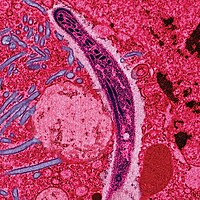
Photo from wikipedia
Purpose Metagenomic next-generation sequencing (mNGS) is a powerful yet unbiased method to identify pathogens in suspected infections. However, little is known about its clinical effectiveness. The present study aimed to… Click to show full abstract
Purpose Metagenomic next-generation sequencing (mNGS) is a powerful yet unbiased method to identify pathogens in suspected infections. However, little is known about its clinical effectiveness. The present study aimed to assess the efficacy of mNGS in routine clinical practice. Patients and Methods In this single-center retrospective cohort study, 518 patients with suspected infectious diseases were assessed for inclusion. Among them, each patient had undergone mNGS testing; 407 patients had undergone both microbial culture and mNGS testing. The result of mNGS testing was compared to microbial culture performed concurrently. The diagnostic performance of mNGS was evaluated using the comprehensive clinical diagnosis as the reference standard. Results There was a significant difference in the positive detection rates of pathogens between mNGS and culture (331/407, 81.3% vs 79/407, 19.4%, P < 0.001). The sensitivity of mNGS was much higher than the culture method (79.5% vs 21.3%, P < 0.001), especially in sample types of sputum and bronchoalveolar lavage fluid (BALF). Notably, the sensitivity of blood mNGS was relatively lower than other sample types (67.4% vs 88.9–93.8%). Pathogen cfDNA load based on standardized stringently mapped read number at the species level of microorganisms (SDSMRN) was significantly lower in blood than in other sample types from the same patient (P = 0.0003). Importantly, mNGS directly led to a change of treatment regimen in 142 (27.4%) cases, including antibiotic escalation (15.3%), antibiotic de-escalation (9.1%), and early definitive diagnosis to initiate appropriate treatment (3.1%). Conclusion Our in-house mNGS platform significantly improved the sensitivity for the diagnosis of infectious diseases. mNGS has the potential to improve clinical outcomes by optimizing antimicrobial therapy.
Journal Title: Infection and Drug Resistance
Year Published: 2023
Link to full text (if available)
Share on Social Media: Sign Up to like & get
recommendations!